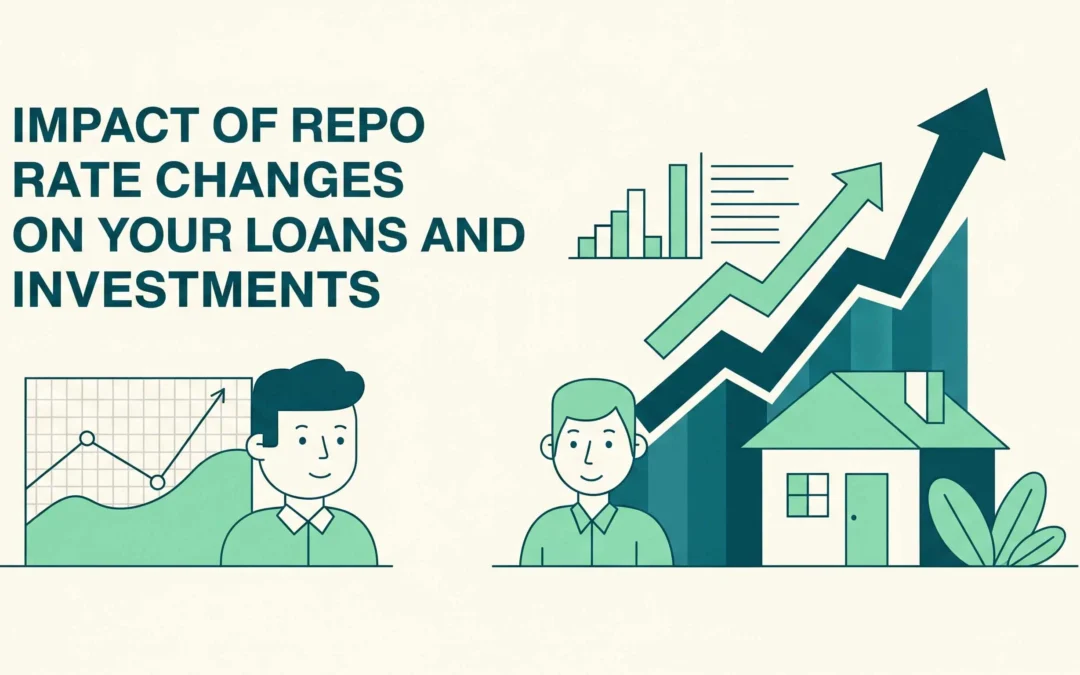Repo rate is an essential tool in the economy used to control the money flow. It is changed as and when required according to the prevailing market conditions. Even a slight change can cause a huge impact on the lives of common people who utilize the facilities like loans and investments associated with banks.
This article will help you understand repo rate and the impact it has on your loan and investment, even with a slight change.
What is Repo Rate?
The interest rate at which the RBI lends commercial banks for short-term is known as the repo rate. Interest rates for investors and borrowers are impacted by changes in this rate, which have an impact on the entire financial system.
Key Features of Repo Rate:
- Manage inflation: Spending decreases when borrowing becomes more expensive due to a higher repo rate.
- Increase liquidity: Banks are more inclined to borrow money and give loans at lower rates when the repo rate is lower.
- Impact market sentiment: Short-term changes in the stock and bond markets are frequently influenced by repo rate announcements.
How Repo Rate Changes Impact Your Investments in India?
1. Small savings plans and fixed deposits (FDs)
Banks offer higher interest rates on fixed deposits when repo rates rise, which attracts investors. Investors who are risk-averse, particularly elderly individuals or those who depend on interest income, benefit from this.
When repo rates decline, FD rates also decline, which reduces the appeal of these instruments in comparison to alternatives linked to the market.
2. Mutual Funds for Debt
Interest rate fluctuations have a significant impact on debt fund returns. As yields fluctuate, so do their underlying assets, which include government securities, money market instruments, and corporate bonds.
An increase in the Repo Rate means the NAV of long-duration debt funds decreases as bond prices fall. Bond prices increase when the repo rate declines, which raises investor returns and NAVs.
| Debt Fund Type | Best During | Why? |
| Short Duration Funds | Rising/Firm repo rates | Less interest rate sensitivity |
| Long Duration Funds | Falling repo rates | Capital gains from bond price appreciation |
| Liquid/Money Market | Stable repo rates | Low risk, predictable returns |
3. Sectoral Impact of Equity Markets
Although they are not directly related, changes in consumer spending, cost of capital, and liquidity all affect how the equity market responds to changes in repo rates.
Reduced repo rates:
- Lower business loan interest results in increased profits.
- Increased customer demand results in higher profits for businesses.
- Lower cost of borrowing facilitates the expansion of businesses.
Increased rates for repos:
- Damaged rate-sensitive industries, such as infrastructure and housing.
- Urge investors to switch to fixed-income, safer investments.
How Repo Rate Affects Your Loan EMIs?
The points below will help you understand how the repo rate affects loans and EMI:
1. Floating-rate home loans
The repo rate has a direct impact on home loans with floating rates. Banks raise their lending rates in response to the RBI repo rate increases, which drives up the cost of EMIs. In a similar vein, lowering the repo rate lowers interest rates, which lessens the burden of EMIs for borrowers.
For instance, for a home loan of Rs. 20 lakh with a 10-year term:
- EMI is approximately Rs 24,266 at an interest rate of 8.0%.
- EMI increases to Rs. 24,797 if the repo rate rises by 0.50% (8.5%).
2. Personal and Auto Loans
Personal and auto loans can be either fixed or variable, and they typically have shorter terms (2–7 years).
- A hike in the repo rate raises borrowing costs, which drives up the cost of loans.
- On the other hand, the reduction in the repo rate increases borrowing of loans by lowering the cost.
3. Loans for Education and Businesses
These loans, which are frequently taken out over longer periods of time, are extremely susceptible to fluctuations in interest rates. For entrepreneurs and students:
- A rise in the repo rate affects repayment capacity by raising the cost of capital and education.
- A reduction in the repo rate reduces financial strain and encourages investments in business expansion or skill improvement.
| Loan Type | Effect of Repo Rate Hike | Effect of Repo Rate Cut |
| Home Loan | EMI rises, total interest outgo increases | EMI falls, improves affordability |
| Auto Loan | Monthly payment increases, lowering the new demand | Cheaper EMIs boost vehicle affordability |
| Personal Loan | Higher cost of borrowing for urgent needs | Makes personal financing more attractive |
| Education Loan | Higher long-term repayment burden | Eases the financial load on students |
| Business Loan (MSME) | Expansion costs rise; capital becomes expensive | Easier access to loans supports business growth |
Bottomline
The conclusion can be drawn that the repo rate has a huge impact on the economy as a whole. When the RBI lends to other banks at a lower rate, then banks also offer loans at a lower interest rate, increasing the money in the economy.
On the other hand, when the RBI increases the repo rate, banks attract capital from investment by offering a higher interest rate, pulling back the money from the economy. This activity highly influences the loan and investment activity. So, it is important to understand such factors that directly impact the cost of a loan and the return on investment.
Written by: Tanya Kumari


